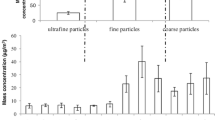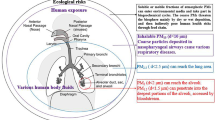Abstract
A significant knowledge gap in nanotechnology is the absence of standardized protocols for examining and comparison the effect of metal oxide nanoparticles on different environment media. Despite the large number of studies on ecotoxicity of nanoparticles, most of them disregard the particles physicochemical transformation under real exposure conditions and interaction with different environmental components like air, soil, water, etc. While one of the main exposure ways is inhalation and/or atmosphere for human and environment, there is no investigation between airborne particulates and nanoparticles. In this study, some metal oxide nanoparticle (ZnO and TiO2) transformation and behavior in PM2.5 air particulate media were examined and evaluated by the influence on nanoparticle physicochemical properties (size, surface charge, surface functionalization) and on bacterium (Gram-positive Bacillus subtilis, Staphylococcus aureus/Gram-negative Escherichia coli, Pseudomonas aeruginosa bacteria) by testing in various concentrations of PM2.5 airborne particulate media to contribute to their environmental hazard and risk assessment in atmosphere. PM2.5 airborne particulate media affected their toxicity and physicochemical properties when compared the results obtained in controlled conditions. ZnO and TiO2 surfaces were functionalized mainly with sulfoxide groups in PM2.5 air particulates. In addition, tested particles were not observed to be toxic in controlled conditions. However, these were observed inhibition in PM2.5 airborne particulates media by the exposure concentration. These observations and dependence of the bacteria viability ratio explain the importance of particulate matter-nanoparticle interaction.






Similar content being viewed by others
References
Aruoja, V., Pokhrel, S., Sihtmäe, M., Mortimer, M., Mädler, L., & Kahru, A. (2015). Toxicity of 12 metal-based nanoparticles to algae, bacteria and protozoa. Environmental Science: Nano, 2, 630–644.
Baek, Y. W., & An, Y. J. (2011). Microbial toxicity of metal oxide nanoparticles (CuO, NiO, ZnO, and Sb2O3) to Escherichia coli, Bacillus subtilis, and Streptococcus aureus. Science of Total Environment, 409(8), 1603–1608. https://doi.org/10.1016/j.scitotenv.2011.01.014.
Bakand, S., Hayes, A., & Dechsakulthorn, F. (2012). Nanoparticles: A review of particle toxicology following inhalation exposure. Inhalation Toxicology, 24(2), 125–135. https://doi.org/10.3109/08958378.2010.642021.
Beveridge, T. J. (1999). Structures of gram-negative cell walls and their derived membrane vesicles. Journal of Bacteriology, 181(16), 4725–4733.
Bondarenko, O. M., Heinlaan, M., Sihtmäe, M., Ivask, A., Kurvet, I., Joonas, E., Jemec, A., Mannerström, M., Heinonen, T., Rekulapelly, R., Singh, S., Zou, J., Pyykkö, I., Drobne, D., & Kahru, A. (2016). Multilaboratory evaluation of 15 bioassays for (eco)toxicity screening and hazard ranking of engineered nanomaterials: FP7 project NANOVALID. Nanotoxicology, 10(9), 1229–1242. https://doi.org/10.1080/17435390.2016.1196251.
Braakhuis, H. M., Park, M. V. D. Z., Gosens, I., De Jong, W. H., & Cassee, F. R. (2014). Physicochemical characteristics of nanomaterials that affect pulmonary inflammation. Particle and Fibre Toxicology, 11(1), 18. https://doi.org/10.1186/1743-8977-11-18.
Brayner, R., Ferrari-Iliou, R., Brivois, N., Djediat, S., Benedetti, M. F., & Fievet, F. (2006). Toxicological impact studies based on Escherichia coli bacteria in ultrafine ZnO nanoparticles colloidal medium. Nano Letters, 6(4), 866–870. https://doi.org/10.1021/nl052326h.
Brown, S., Meredith, T., Swoboda, J., & Walker, S. (2010). Staphylococcus aureus and Bacillus subtilis W23 make polyribitol wall teichoic acids using different enzymatic pathways. Chemistry & Biology, 17(10), 1101–1110. https://doi.org/10.1016/j.chembiol.2010.07.017.
Brown, S., Santa Maria Jr., J. P., & Walker, S. (2013). Wall teichoic acids of gram-positive bacteria. Annual Review of Microbiology, 67, 1–28.
Chang, Y. N., Zhang, M., Xia, L., Zhang, J., & Xing, G. (2012). The toxic effects and mechanisms of CuO and ZnO nanoparticles. Materials, 5(12), 2850–2871. https://doi.org/10.3390/ma5122850.
Cho, W. S., Duffin, R., Poland, C. A., Howie, S. E. M., MacNee, W., Bradley, M., Megson, I. L., & Donaldson, K. (2010). Metal oxide nanoparticles induce unique inflammatory footprints in the lung: Important implications for nanoparticle testing. Environmental Health Perspectives, 118(12), 1699–1705. https://doi.org/10.1289/ehp.1002201.
Creutzenberg, O. (2013). Toxic effects of various modifications of a nanoparticle following inhalation. Research Project F 2246. Germany: The Federal Institute for Occupational Safety and Health.
Cullen, R. T., Tran, C. L., Buchanan, D., Davis, J. M., Searl, A., Jones, A. D., & Donaldson, K. (2000). Inhalation of poorly soluble particles. I. Differences in inflammatory response and clearance during exposure. Inhalation Toxicology, 12(12), 1089–1111. https://doi.org/10.1080/08958370050166787.
Djurisic, A. B., Leung, Y. H., Ng, A. M. C., Xu, X. Y., Lee, P. H., Degger, N., & Wu, R. S. S. (2015). Toxicity of metal oxide nanoparticles: Mechanisms, characterization, and avoiding experimental artefacts. Small, 11(1), 26–44. https://doi.org/10.1002/smll.201303947.
Englert, N. (2004). Fine particles and human health—A review of epidemiological studies. Toxicological Letters, 149(1-3), 235–242. https://doi.org/10.1016/j.toxlet.2003.12.035.
Faure, B., Salazar-Alvarez, G., Ahniyaz, A., Villaluenga, I., Berriozabal, G., De Miguel, Y. R., & Bergström, L. (2013). Dispersion and surface functionalization of oxide nanoparticles for transparent photocatalytic and UV-protecting coatings and sunscreens. Science and Technology of Advanced Materials, 14(2), 023001. https://doi.org/10.1088/1468-6996/14/2/023001.
Fu, P. P., Xia, Q., Hwang, H. M., Ray, P. C., & Yu, H. (2014). Mechanisms of nanotoxicity: Generation of reactive oxygen species. Journal of Food and Drug Analysis, 22(1), 64–75. https://doi.org/10.1016/j.jfda.2014.01.005.
Gawande, M. B., Pandey, R. K., & Radha, J. V. (2012). Role of mixed metal oxides in catalysis science—Versatile applications in organic synthesis. Catalysis Science and Technology, 2(6), 1113–1125. https://doi.org/10.1039/c2cy00490a.
Geiser, M., Wigge, C., Conrad, M. L., Eigeldinger-Berthou, S., Künzi, L., Garn, H., Renz, H., & Mall, M. A. (2014). Nanoparticle uptake by airway phagocytes after fungal spore challenge in murine allergic asthma and chronic bronchitis. BMC Pulmonary Medicine, 14(1), 116. https://doi.org/10.1186/1471-2466-14-116.
Handy, R. D., von der Kammer, F., Lead, J. R., Hassellov, M., Owen, R., & Crane, M. (2008). The ecotoxicology and chemistry of manufactured nanoparticles. Ecotoxicology, 17(4), 287–314. https://doi.org/10.1007/s10646-008-0199-8.
Huang, K. C., Mukhopadhyay, R., Wen, B., Gitai, Z., & Wingreen, N. S. (2008). Cell shape and cell-wall organization in Gram-negative bacteria. Proceedings of the National Academy of Sciences, 105(49), 19282–19287. https://doi.org/10.1073/pnas.0805309105.
Jiang, W., Mashayekhi, H., & Xing, B. (2009). Bacterial toxicity comparison between nano- and micro-scaled oxide particles. Environmental Pollution, 157(5), 1619–1625. https://doi.org/10.1016/j.envpol.2008.12.025.
Kroll, A., Pillukat, M. H., Hahn, D., & Schnekenburger, J. (2009). Current in vitro methods in nanoparticle risk assessment: Limitations and challenges. European Journal of Pharmaceutics and Biopharmaceutics, 72(2), 370–377. https://doi.org/10.1016/j.ejpb.2008.08.009.
Kumar, P., Robins, A., Vardoulakis, S., & Britter, R. (2010). A review of the characteristics of nanoparticles in the urban atmosphere and the prospects for developing regulatory controls. Atmospheric Environment, 44(39), 5035–5052. https://doi.org/10.1016/j.atmosenv.2010.08.016.
Landsiedel, R., Ma-Hock, L., Hofmann, T., Wiemann, M., Strauss, V., Treumann, S., Wohlleben, W., Gröters, S., Wiench, K., & van Ravenzwaay, B. (2014). Application of short-term inhalation studies to assess the inhalation toxicity of nanomaterials. Particle and Fibre Toxicology, 11(16), 1–26. https://doi.org/10.1186/1743-8977-11-16.
Lee, W. M., An, Y. J., Yoon, H., & Kweon, H. S. (2008). Toxicity and bioavailability of copper nanoparticles to the terrestrial plants mung bean (Phaseolus Radiatus) and wheat (Triticum Aestivum): Plant agar test for water-insoluble nanoparticles. Environmental Toxicology and Chemistry, 27(9), 1915–1921. https://doi.org/10.1897/07-481.1.
Leung, Y. H., Xu, X., Ma, A. P., Liu, F., Ng, A. M., Shen, Z., Gethings, L. A., Guo, M. Y., Djurisic, A. B., Lee, P. K., Lee, H. K., Chan, W. K., & Leung, F. C. (2016). Toxicity of ZnO and TiO2 to Escherichia coli cells. Scientific Reports, 6(1), 35243. https://doi.org/10.1038/srep35243.
Lu, S., Duffin, R., Poland, C., Daly, P., Murphy, F., Drost, E., MacNee, W., Stone, V., & Donaldson, K. (2009). Efficacy of simple short-term in vitro assays for predicting the potential of metal oxide nanoparticles to cause pulmonary inflammation. Environmental Health Perspectives, 117(2), 241–247. https://doi.org/10.1289/ehp.11811.
Matias, V. R. F., Al-Amoudi, A., Dubochet, J., & Beveridge, T. J. (2003). Cryo-transmission electron microscopy of frozen-hydrated sections of Escherichia coli and Pseudomonas aeruginosa. Journal of Bacteriology, 185(20), 6112–6118. https://doi.org/10.1128/JB.185.20.6112-6118.2003.
Ma-Hock, L., Strauss, V., Treumann, S., Küttler, K., Wohlleben, W., Hofmann, T., Gröters, S., Wiench, K., van Ravenzwaay, B., & Landsiedel, R. (2013). Comparative inhalation toxicity of multi-wall carbon nanotubes, graphene, graphite nanoplatelets and low surface carbon black. Particle and Fibre Toxicology, 10(1), 23. https://doi.org/10.1186/1743-8977-10-23.
Navarro, E., Baun, A., Behra, R., Hartmann, N. B., Filser, J., Miao, A. J., Quigg, A., Santschi, P. H., & Sigg, L. (2008). Environmental behavior and ecotoxicity of engineered nanoparticles to algae, plants, and fungi. Ecotoxicology, 17(5), 372–386. https://doi.org/10.1007/s10646-008-0214-0.
Ninganagouda, S., Rathod, V., Singh, D., Hiremath, J., Singh, A. K., Mathew, J., & ul-Haq, M. (2014). Growth kinetics and mechanistic action of reactive oxygen species released by silver nanoparticles from Aspergillus niger on Escherichia coli. BioMed Research International, 2014, 1–9. http://dx.doi.org/10.1155/2014/753419
Nur, Y., Lead, J. R., & Baalousha, M. (2015). Evaluation of charge and agglomeration behavior of TiO2 nanoparticles in ecotoxicological media. Science of the Total Environment, 535, 45–53. https://doi.org/10.1016/j.scitotenv.2014.11.057.
Padmavathy, N., & Vijayaraghavan, R. (2011). Interaction of ZnO nanoparticles with microbes—A physio and biochemical assay. Journal of Biomedical Nanotechnology, 7, 1–10.
Pope, C. A., Burnett, R. T., Thun, M. J., Calle, E. E., Krewski, D., Ito, K., & Thurston, G. D. (2002). Lung cancer, cardiopulmonary mortality, and long-term exposure to fine particulate air pollution. Journal of the American Medical Association, 287(9), 1132–1141. https://doi.org/10.1001/jama.287.9.1132.
Qiao, H., Liu, W., Gu, H., Wang, D., & Wang, Y. (2015) The transport and deposition of nanoparticles in respiratory system by inhalation. Journal of Nanomaterials, 2015, 1–8. http://dx.doi.org/10.1155/2015/394507
Ramphal, R., Carnoy, C., Fievre, S., Michalski, J. C., Houdret, N., Lamblin, G., Strecker, G., & Roussel, P. (1991). Pseudomonas Aeruginosa recognizes carbohydrate chains containing type 1 (gal3l-3glcnac) or type 2 (gaip1-4g1cnac) disaccharide units. Infection and Immunity, 59(2), 700–704.
Roper, C., Chubb, L. G., Cambal, L., Tunno, B., Clougherty, J. E., & Mischler, S. E. (2015). Characterization of ambient and extracted PM2.5 collected on filters for toxicology applications. Inhalation Toxicology, 27(13), 673–681. https://doi.org/10.3109/08958378.2015.1092185.
Saviozzi, A., & Cardelli, R. (2014). Organic matter characteristics, biochemical activity and antioxidant capacity of soil amended with different organic materials. Journal. Archives of Agronomy and Soil Science, 60(1), 119–131. https://doi.org/10.1080/03650340.2013.767444.
Silhavy, T. J., Kahne, D., & Walker, S. (2010). The bacterial cell envelope. Cold Spring Harbor Perspectives in Biology, 2, a000414.
Simon-Deckers, A., Loo, S., Mayne-L’hermite, M., Herlin-Boime, N., Menguy, N., Reynaud, C., Gouget, B., & Carrière, M. (2009). Size-, composition- and shape-dependent toxicological impact of metal oxide nanoparticles and carbon nanotubes toward bacteria. Environmental Science and Technology, 43(21), 8423–8429. https://doi.org/10.1021/es9016975.
Sirelkhatim, A., Mahmud, S., Seeni, A., Kaus, N. H. M., Ann, L. C., Bakhori, S. K. M., Hasan, H., & Mohamad, D. (2015). Review on zinc oxide nanoparticles: Antibacterial activity and toxicity mechanism. Nano-Micro Letters, 7(3), 219–242. https://doi.org/10.1007/s40820-015-0040-x.
Sorig-Hougaard, K., Campagnolo, L., Chavatte-Palmer, P., Tarrade, A., Rousseau-Ralliard, D., Valentino, S., Park, M. V. D. Z., de Jong, W. H., Wolterink, G., Piersma, A. H., Ross, B. L., Hutchison, G. R., Hansen, J. S., Vogel, U., Jackson, P., Slama, R., Pietroiusti, A., & Cassee, F. R. (2015). A perspective on the developmental toxicity of inhaled nanoparticles. Reproductive Toxicology, 56, 118–140. https://doi.org/10.1016/j.reprotox.2015.05.015.
Sperling, R. A., & Parak, W. J. (2010). Surface modification, functionalization and bioconjugation of colloidal inorganic nanoparticles. Philosophical Transactions of the Royal Society A, 368(1915), 1333–1383. https://doi.org/10.1098/rsta.2009.0273.
Stone, V., Johnston, H., & Clift, M. J. D. (2007). Air pollution, ultrafine and nanoparticle toxicology: Cellular and molecular interactions. IEEE Transactions on Nanobioscience, 6(4), 331–340. https://doi.org/10.1109/TNB.2007.909005.
Szigeti, T., Mihucz, V. G., Óvári, M., Baysal, A., Atılgan, S., Akman, S., & Záray, G. (2013). Chemical characterization of PM2.5 fractions of urban aerosol collected in Budapest and Istanbul. Microchemical Journal, 107, 86–94. https://doi.org/10.1016/j.microc.2012.05.029.
Warheit, D. B., Sayes, C. M., & Reed, K. L. (2009). Nanoscale and fine zinc oxide particles: Can in vitro assays accurately forecast lung hazards following inhalation exposures? Environmental Science and Technology, 43(20), 7939–7945. https://doi.org/10.1021/es901453p.
Watanabe, M., Noma, H., Kurai, J., Sano, H., Hantan, D., Ueki, M., Kitano, H., & Shimizu, E. (2017). A panel study of airborne particulate matter composition versus concentration: Potential for inflammatory response and impaired pulmonary function in children. Allergology International, 66(1), 52–58. https://doi.org/10.1016/j.alit.2016.04.014.
Yang, K., Li, Y., Tan, X., Peng, R., & Liu, Z. (2013). Behavior and toxicity of graphene and its functionalized derivatives in biological systems. Small, 9(9-10), 1492–1503. https://doi.org/10.1002/smll.201201417.
Yokohira, M., Kuno, T., Yamakawa, K., Hosokawa, K., Matsuda, Y., Hashimoto, N., Suzuki, S., Saoo, K., & Imaida, K. (2008). Lung toxicity of 16 fine particles on intratracheal instillation in a bioassay model using F344 male rats. Toxicologic Pathology, 36(4), 620–631. https://doi.org/10.1177/0192623308318214.
Acknowledgements
The authors would like to express their thanks to Prof. Dr. Suleyman Akman, Istanbul Technical University, Faculty of Science and Letters, Chemistry Dept. for airborne particulate samples; Assoc. Prof. Dr. Filiz Altay, Istanbul Technical University, Faculty of Chemical and Metallurgical Engineering, Food Engineering dept.; Assoc. Prof. Dr. Mustafa Kumral Istanbul Technical University, Faculty of Mines, Geological Engineering dept.; and Assoc. Prof. Dr. Mustafa Ozyurek, Istanbul University, Engineering Faculty, Chemistry Dept., for the instrumentation of DLS, XRF, and FTIR analysis.
Author information
Authors and Affiliations
Corresponding author
Rights and permissions
About this article
Cite this article
Baysal, A., Saygin, H. & Ustabasi, G.S. Interaction of PM2.5 airborne particulates with ZnO and TiO2 nanoparticles and their effect on bacteria. Environ Monit Assess 190, 34 (2018). https://doi.org/10.1007/s10661-017-6408-2
Received:
Accepted:
Published:
DOI: https://doi.org/10.1007/s10661-017-6408-2




